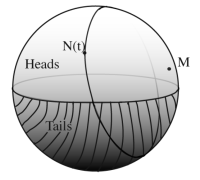November 22, 2007
No Such Thing as a Fair Coin?
 Diaconis, P., Holmes, S. and Montgomery, R. Dynamical Bias in the Coin Toss, SIAM Review vol 49:2, pp 211-235 analyses the process of flipping a coin. Even when vigorously flipped the coin turns out to come up more often the same way as it started. The discrepancy is small - p=0.51 for same side up, something which it would take about 250,000 trial flips to check - but it is hard to get away from.
Diaconis, P., Holmes, S. and Montgomery, R. Dynamical Bias in the Coin Toss, SIAM Review vol 49:2, pp 211-235 analyses the process of flipping a coin. Even when vigorously flipped the coin turns out to come up more often the same way as it started. The discrepancy is small - p=0.51 for same side up, something which it would take about 250,000 trial flips to check - but it is hard to get away from.
The reason, as described in the paper, is that the fairness of a throw is dependent on the angle between the rotation axis and the normal of the coin. Imagine a coin thrown straight up, rotating around a vertical axis. Such a coin would of course land with the same face up, being 100% unfair. A coin rotating around an axis through its edge would on the other hand tend to be fair (if it rotated enough times that initial uncertainty in the flip became magnified enough). But a coin with a rotation axis inbetween would be somewhat unfair. The analysis gets a bit more complex due to precession, but it seems that averaged over all rotation axes we get a bias towards same side up. Experimental testing then seemed to confirm this dynamics.
Of course, if the original top side is hidden things become fair again.